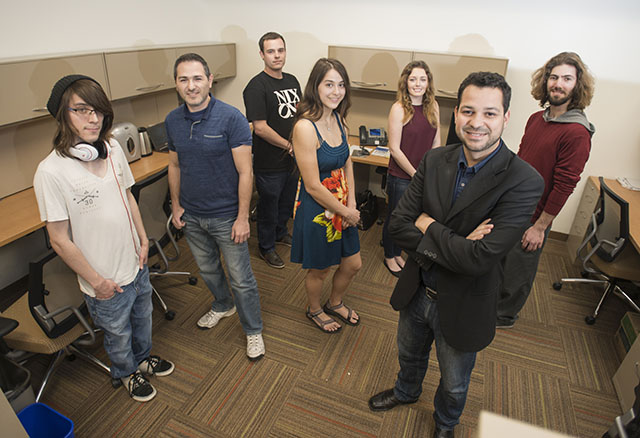CSUN Theoretical Astrophysics Professor Studies Planet Formation

Left to right, CSUN undergraduate Blake Tinoco, physics professor Karapet Karapetyan, undergraduate Sean Snyder, graduate Alexandra Yep, graduate Amanda Rowen, theoretic astrophysicist and professor Wladimir Lyra, and graduate Michael Artinian comprise the team of computer-based astrophysics studies at CSUN. Photo by Lee Choo.
A cluster of California State University, Northridge students gathered with professor Wladimir Lyra to analyze the latest astrophysics data. But these data were not captured by a telescope. Instead they were focused on a YouTube video of Lyra’s most recent 3-D computer model, a simulation of a planet forming from particles around a star in space.
As CSUN’s first theoretical astrophysics professor in years, Lyra’s expertise provides his colleagues and students a novel approach to understanding stars and planets — via inputting complex mathematic equations to one of the world’s largest supercomputers, Stampede.
In December 2015, Lyra received 1.5 million computer hours from the National Science Foundation’s National Center for Supercomputing (NICS) and Extreme Science and Engineering Discovery Environment (XSEDE) to use on Stampede’s 100,000 processors. He explained that because of his access to Stampede, he and his students can now run multiple models in shorter amounts of time than was possible before the supercomputer’s 2013 inception.
“It was amazing to see Stampede,” he said. “You suddenly have access to thousands of processors. It uses as much energy as a small city!”
Karapet Karapetyan, a 2012 CSUN physics graduate alumnus, associate physics professor and colleague of Lyra, explained that computer simulations allow astrophysicists to study universal activity that cannot be observed through a telescope.
“The major thing about astronomy is that we cannot study and observe, [for example], a star from its birth until it dies billions of years later,” he said. “The simulations give us a way to somehow look at the evolution of these bodies.”
Lyra is currently mentoring four graduate and two undergraduate physics students. Lyra, together with a graduate student Amanda Rowen, is simulating the geophysical behavior of Europa, one of Jupiter’s icy moons that may contain life. The simulation will help Jet Propulsion Laboratory (JPL) understand the moon’s surface features.
“I am building software to model the ice shell on Europa,” Lyra explained. “It has a crust of ice, and under this ice we have pretty good evidence that it has an ocean. There are surface features that can be easily explained by water, at least by convection in the ice.”
Convection is the movement caused within a fluid, like water, by the tendency of hotter and less dense material to rise and colder, denser material to sink due to gravity.
“We are going to model that in detail,” he continued. “This is very interesting for the Europa mission [that JPL] is going to launch in the early 2020s. These are pretty exciting times.”
Without a computer model, it would take up to 200,000 years to observe a full cycle of Europa. It takes a matter of days running the proper equations for convection through Stampede’s processors, Lyra said.
Rowen said she is excited to work on the simulation.
“During my undergrad here, I did icy moons as well. Icy moons are interesting because we can actually get to them in our solar system,” she said. “I am mostly excited because we are essentially trying to figure out things that nobody on Earth knows yet.”
CSUN astronomy and physics department chair Say-Peng Lim said Lyra’s astrophysics work taps into students’ desires to learn more about the subject.
“We had always had a stronger emphasis on solar physics because of the gift of the San Fernando Observatory to CSUN by the Aerospace Corporation,” he said. “There is a lot of student interest in astrophysics, so we decided to bring someone who specializes in something other than solar physics. Now students have opportunities to work on research projects on astrophysics.”
Undergraduate physics student Sean Snyder said he is looking forward to working with Lyra on planet formation simulations.
“I just think it’s pretty cool that a computer allows us to be able to simulate something within a week that would take billions of years to see,” he said. “I was really excited when I heard Dr. Lyra was coming to CSUN [in fall 2015]. He is a great person to work with and he is really helpful.”
Lyra is eager to expose more students — especially undergraduates — to building their confidence in theoretic astrophysics research.
“The students here traditionally come from underprivileged backgrounds … a significant fraction of them are the first ones in their families to come to college. I am a person who cares a lot about the social aspect of science,” he said. “Science can and should be a way to advance social equality.”
As of 2013, about 65 percent of CSUN students are first generation college students, and more than 40 percent come from low-income families, according to university data.
“One of the things I hear a lot with the students here is that they would like to work with me, but they don’t think that they are bright enough,” Lyra continued. “A big chunk of the students is smart, but they don’t know it. They are as smart as [California Institute of Technology students], but not everyone can pay a Caltech tuition. I hope that when they start doing research, and they see that they are progressing, they realize that they can do this work. This is a reward from being at CSUN that brings me a sense of personal and social fulfillment.”

 experience
experience